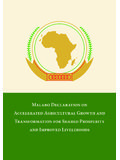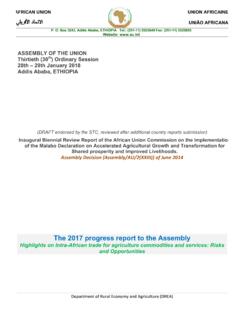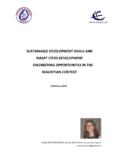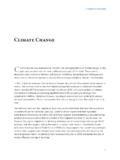Transcription of CHAPTER 5 Trade, Climate Change, and Climate …
1 54 CHAPTER 5 Trade, Climate change , and Climate - smart AgricultureBeliyou Haile, Carlo Azzarri, Jawoo Koo, and Alessandro De Pinto1616 The authors acknowledge the generous support of the CGIAR Research Program on Climate change , agriculture and Food Security (CCAFS), which is carried out with support from CGIAR Fund Donors and through bilateral funding agreements. For details please visit ht tps://cca /donors. We also thank the CGIAR Research Program on Policies, Institutions, and Markets (PIM) for supporting previous initiatives upon which we have built our modeling ReSAKSS Annual Trends and Outlook Report 55 The eradication of poverty in Africa south of the Sahara (SSA), whose poverty rate is the highest in the world, and of its food and nutrition insecurity necessitates structural transformation of the agricultural sector.
2 Meanwhile, global Climate change models suggest an overall warming trend and increased incidence of extreme weather events that vary by altitude (Serdeczny et al. 2017). These changes are expected to have a significant impact on agricultural productivity and the availability of productive resources globally and in SSA, a region that relies heavily on rainfed agriculture (Knox et al. 2012; M ller and Robertson 2014).At the same time, agriculture affects Climate change through anthro-pogenic greenhouse gas (GHG) emissions and by acting as a greenhouse gas sink. GHG emissions result, for instance, from enteric fermentation, application of synthetic fertilizers, land use change , and deforestation, while a sink removes atmospheric GHG by storing (sequestering) it in other forms through photosynthesis.
3 Africa accounted for 15 percent of the world s agriculture -related GHG emissions in 2012, making it the third most important contributor, after Asia (45 percent) and the Americas (25 percent) (Tubiello et al. 2014). Considering the pressure on agricultural production driven by population growth, growth in gross domestic product (GDP) and a consequent change in diets toward higher consumption of animal-source foods, and the risks posed by Climate change , farmers need options to sus-tainably increase production. Climate - smart agriculture (CSA) is one approach that has been promoted to enhance agricultural productivity, food security, and adaptive capacity, while at the same time reducing GHG emissions and increasing carbon sequestration (Campbell et al.)
4 2014; Huang, Lampe, and Tongeren 2011). The CSA approach, which became prominent during the First Global Conference on agriculture , Food Security and Climate change (FAO 2013), is an umbrella term that includes many strategies built upon location-specific solutions that are expected to contribute toward achievement of the Sustainable Development Goals (SDGs). It relies on agricultural systems that contribute to three outcomes: (1) sustainable and equitable increases in agricultural productivity and income; (2) greater resilience of food systems and farming livelihoods, and (3) reduction and removal of GHG emissions associated with agriculture , wherever possible. Agricultural production systems that follow the tenets of CSA are expected to be not only more productive and efficient, but also resilient to short-, medium-, and long-term shocks and risks associated with Climate change and variability.
5 The CSA approach represents a departure from the single-objective approach that underlies most work to ensure food and nutrition security. CSA s multi-objective approach facilitates important conversations, negotia-tions, and coordination of interventions among different ministries. Many operational aspects of CSA, however, are still under investigation. Local contexts determine the enabling environment, the trade-offs, and the synergies of CSA, so practices and technologies may be Climate smart in some circumstances and conditions but not in others. Therefore, how these practices deliver across the three pillars of CSA, and the conditions for their adoption, are highly specific to contexts and locations, with fundamental implications for the operational aspects of CSA (McCarthy, Lipper, and Branca 2011).
6 Indeed, short-term productivity may even decrease under CSA (Pittelkow et al. 2015), with more stable and often increasing yields observed over time, especially under dry or drought-stressed conditions (Corbeels et al. 2014; Pittelkow et al. 2015).56 approach being promoted to ensure the eradication of extreme poverty and promote inclusive and sustainable development, especially in the face of Climate -induced changes in the amount and distribution of produc-tion, is trade (Sommer and Luke 2016). Trade is recognized as a cross-cutting means of implementing the 2030 Agenda for Sustainable Development under SDG 17. Agricultural commodity trade in Africa has increased steadily over the past 30 years, with net exports (exports minus imports) rising from 2 to 6 percent of GDP between 1980 and 2014 (IMF 2016).
7 Despite these improvements, the region not only accounts for a small share of the global commodity trade but has one of the lowest intraregional trades in goods (16 percent, versus 17 percent for South and Central America, 42 percent for North America, 62 percent for the European Union, and 64 percent for Asia) (Davis 2016; Khandelwal 2005; Tamiotti et al. 2009). Although a number of regional economic communities (RECs) have been established to promote economic integration and trade, including the Common Market for Eastern and Southern Africa (COMESA),17 the Economic Community of West African States (ECOWAS),18 and the Southern African Development Community (SADC),19intraregional trade remains staggeringly low. For example, between 2001 and 2010, intraregional trade grew at 2 percent, percent, and percent per year, on average, for ECOWAS, SADC, and COMESA, respectively, and intraregional trade 17 COMESA includes Burundi, Comoros, Democratic Republic of the Congo, Djibouti, Egypt, Eritrea, Ethiopia, Kenya, Libya, Madagascar, Malawi, Mauritius, Rwanda, Seychelles, Sudan, Swaziland, Uganda, Zambia, and ECOWAS includes Benin, Burkina Faso, Cabo Verde, C te d Ivoire, Gambia, Ghana, Guinea, Guinea-Bissau, Liberia, Mali, Niger, Nigeria, Senegal, Sierra Leone, and SADC includes Angola, Botswana, Democratic Republic of the Congo, Lesotho, Madagascar, Malawi, Mauritius, Mozambique, Namibia, Seychelles, South Africa.
8 Swaziland, United Republic of Tanzania, Zambia, and Zimbabwe, of which eight also belong to for 9 percent, percent, and percent of the total trade, on average, for ECOWAS, SADC, and COMESA, respectively (Seid 2013). But intraregional trade is expected to increase in the coming decades, thanks to an emerging favorable trade environment including the establishment of the African Continental Free Trade Area (UNCTAD 2016); the Malabo declara-tion, aimed at tripling intracontinental trade in agricultural commodities and services by 2025; and the African Union s Agenda 2063, which aims to increase intracontinental trade from 12 percent to 50 percent and the con-tinent s share of global trade from 2 percent to 12 percent between 2013 and 2045 (African Union Commission 2015).
9 This CHAPTER examines the role of CSA in mitigating the negative effects of Climate change on yields and commodity trade flows in SSA. The analysis is disaggregated by the three RECs SADC, ECOWAS, and COMESA to capture possible region-specific factors that could mediate the interaction between agricultural production and trade flow as well as potential location specificity in the effectiveness of CSA practices. We simulate the expected effects of adoption of four CSA practices for the period 2018 2025: no tillage (NT) and integrated soil fertility management (ISFM) for maize, and urea deep placement (UDP) and alternate wetting and drying (AWD) for rice. These practices are found to increase agricultural productivity and net exports, highlighting the potential that CSA has in mitigating Climate -induced risks in agricultural production, food security, and foreign currency.
10 2016 ReSAKSS Annual Trends and Outlook Report 57 Conceptual Framework The linkage between Climate change , agricultural production, and trade flow is quite complex, as summarized in Figure Given the reliance of Africa s agriculture on weather and its role in the region s trade, climatic changes such as rising tempera-ture, weather variability, and extreme weather events (such as El Ni o and La Ni a) will have a significant impact on the availability of produc-tive resources, productivity, food security, foreign exchange, and physical infrastructure (M ller and Robertson 2014). Important drivers of the relationship between agriculture and trade in the region are the production landscape and the biophysical conditions.






